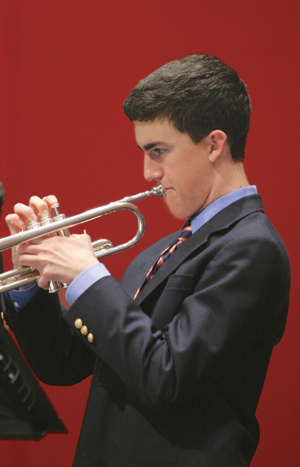 Improvisation is a musical ability that can be learned by any student if enough rehearsal time is set aside. Many directors, especially those who rehearse after school, can get caught up in rehearsing the music and neglect to set aside time for improvisation in every rehearsal. In a one-hour rehearsal I would start with 10 minutes of tuning, long tones, and standard jazz rhythms played in unison with the rhythm section. I would then spend 25 minutes on improvisation and 25 minutes on rehearsing the charts. Following this approach will have most students improvising in 12 weeks.
Improvisation is a musical ability that can be learned by any student if enough rehearsal time is set aside. Many directors, especially those who rehearse after school, can get caught up in rehearsing the music and neglect to set aside time for improvisation in every rehearsal. In a one-hour rehearsal I would start with 10 minutes of tuning, long tones, and standard jazz rhythms played in unison with the rhythm section. I would then spend 25 minutes on improvisation and 25 minutes on rehearsing the charts. Following this approach will have most students improvising in 12 weeks.
Weeks 1-4
At the first rehearsal, make a rule that every student in the jazz band has to solo during every rehearsal. It is unrealistic to have every student solo during a concert, but it should be expected during rehearsals. The first couple weeks will be the most difficult. The soloing will start off slowly with many questions and some confusion, and some students may refuse to solo out of sheer terror at first. One of the most common problems students have when soloing is that they have so much time to fill that they become paralyzed by the options available. By using the melody as a starting point students will feel more comfortable playing a solo.
Start with a simple swing or blues song with an easy-to-remember melody. Make sure every student has the chord changes marked in the music. When this is done, explain what the letters mean and how many beats to give each of the chords in the solo. I then have the entire band play the chord changes with the rhythm section. Students should hold each chord for as long as it lasts; if it lasts the entire measure they should play a whole note, for half a measure they should play a half note. On the first time through the song I would do this three times, stopping after each time to correct any misunderstandings.
Students will then need some ideas on how to improvise based on the melody. There are many ways to create a melody, but students only need to learn two at first. I give students anoption of using the melody of the piece and changing the rhythms, notes, and entrances of the melody; the other option is to use the blues scale and the chords and create a solo from nothing. This will be enough to help them shape the musical ideas in their minds and recreate them with their instruments.
The third is getting students to understand how to use silence effectively in a solo. Using the melody helps teach students about using rests. I compare playing a solo to telling a story, then show how strange it soulds to talk in run-on sentences. I then demonstrate this on an instrument, playing a four bar phrase without rests and then with rests.
Early attempts at improvising should be simple. I have each student take two passes through a solo section, once playing the melody as written and then a second time changing just a few notes and rhythms from the melody. If rehearsal time is limited and there are 20-30 students in the ensemble, shorten the improvisation exercise to be just one time through and have each student play the melody as written for the first four bars and change the melody for the next four. If using 12-bar blues, have students play melody for the first six bars and improvise for the last six.
It is important to designate the order in which students will solo so there is no stopping. To keep students attentive and interested, they are to play the chords quietly when not the soloist. One reason many teachers neglect improvisation in ensemble rehearsals is because of the down time it creates. Having students play chords helps them to learn, hear, and understand the chord changes on the song.
Weeks 5-8
As wind players become accustomed to the routine, I start to pull students out of playing the chords during improvisation practice. This gets students used to counting and playing. For variety I also create background patterns for the students to play behind the soloist.
Take some time to work with the rhythm section. The drummer should start to play turn-arounds, small fills that mark a new phrase, and change the beat pattern slightly. The easiest way to do this is to use the ride cymbal for one soloist and the hi-hat for the next. The drummer should switch back and forth each time to produce some rhythmic variation. The bassist should keep steady time even if the soloists make mistakes. Students at this age can lose their place in the music easily; this is especially true if the soloist messes up the time or plays something erratic or unusual. The guitar and piano players should alternate with each other. Some overlap between the two is acceptable, but if they always play at the same time than the rhythm section will sound heavy, and it will be difficult for the soloist to hear the time and the chords.
The students who seem to be doing the best at improvisation should no longer play the original melody during their solos. They should improvise based off the melody for the entire length of the solo. Those in the middle who can comfortably improvise over four bars should start to improvise for six bars and play only two bars of the melody. Struggling students should continue to work on the structure used during the first four weeks of rehearsals. As alternatives, I might solo with the student, have them write out a solo to play each week, or have them trade four bars with a better-performing student. With improvisation it is impossible to know when the lightbulb will come on, so continue with the basics and be supportive of whatever students play.
Weeks 9-12
As the concert approaches, pick soloists for the songs and start to rehearse the music as it will be performed. Continue to work on improvisation in rehearsals. This will keep the students not improvising during the concert practicing. It is also a good opportunity for students to work on new material rather than get burned out on the concert music. Over the next four weeks students can use easy jazz melodies and chord changes from a fake book. This also is a great opportunity to teach drummers how to read a lead sheet and bass, guitar, and piano players to read and comp over chord changes rather than written out parts.
When planning your improvisation lessons at this level, smaller steps will lead to greater results and a better understanding from your students. This approach should give students a firm foundation in improvisation. Continue improvisation lessons and have students work on jazz standards and study listening examples. Avoid ending rehearsals with improvisation practice; attention will wane as students tire. End class by rehearsing music and give more talented students the opportunity to solo again.






